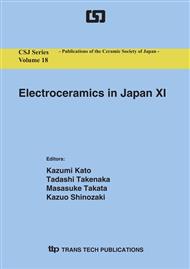p.119
p.123
p.127
p.133
p.137
p.141
p.145
p.149
p.153
Ferroelectric and Luminescent Properties of Electroluminescence Devices Using Ferroelectric Polymer-Phosphor Composite Films
Abstract:
We fabricated and characterized electroluminescence (EL) devices using ferroelectric polyvinylidene fluoride/trifluoroethylene (PVDF/TrFE) copolymer composites mixed with Mn- and Cu-activated ZnS phosphor particles. Spin-coated polymer composite films on glass substrates with transparent conductive oxides were dried at 140 oC for 1 h in vacuum due to growth of ferroelectric phase. The maximum remnant polarization and luminescence of the fabricated devices were approximately 20 μC/cm2 and 100 cd/m2, respectively. Increases of the luminescence were observed in the fabricated EL devices using PVDF/TrFE copolymer in comparison with using PVDF polymer as dielectrics. EL emission intensities were also enhanced by applying the bipolar pulses. These results suggest an effect of polarization reversal in the composite films.
Info:
Periodical:
Pages:
137-140
Citation:
Online since:
September 2008
Authors:
Keywords:
Price:
Сopyright:
© 2009 Trans Tech Publications Ltd. All Rights Reserved
Share:
Citation:


